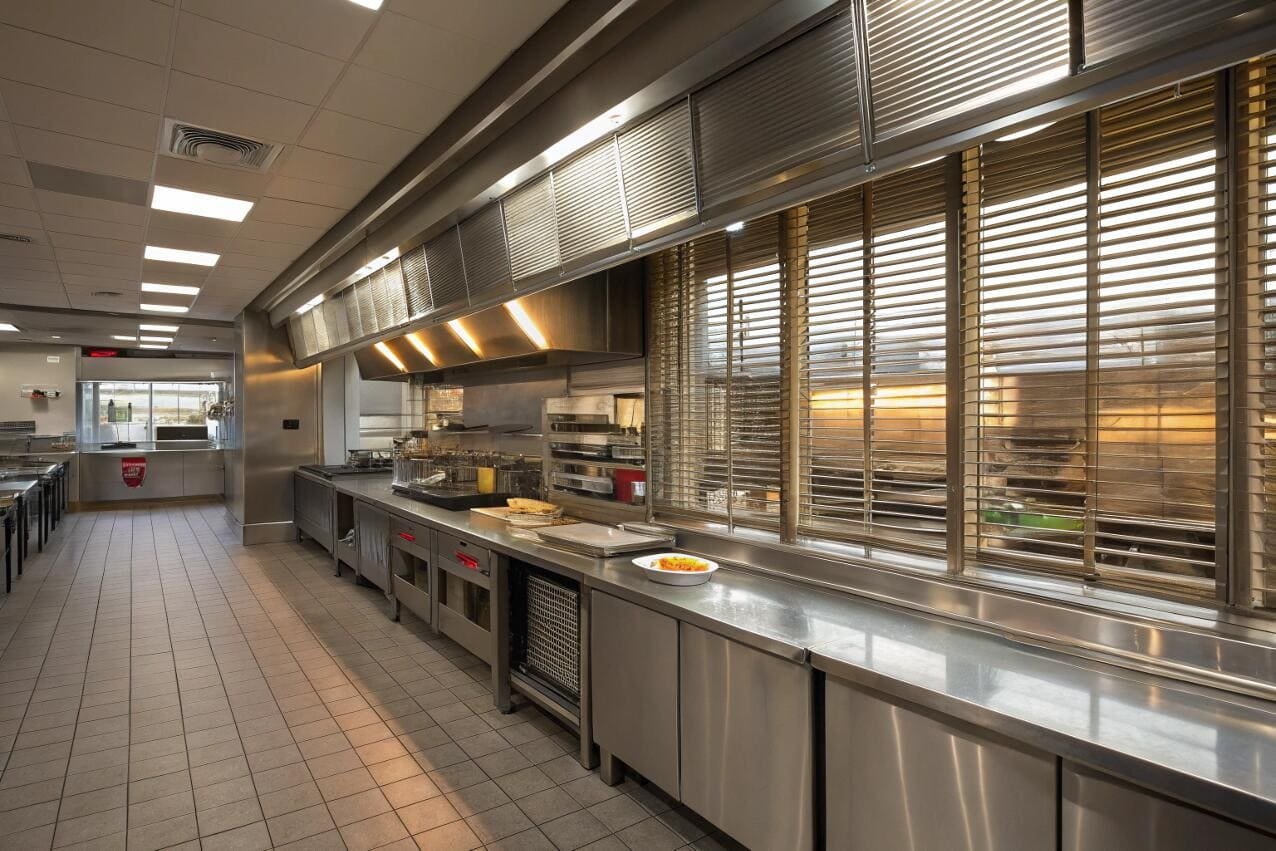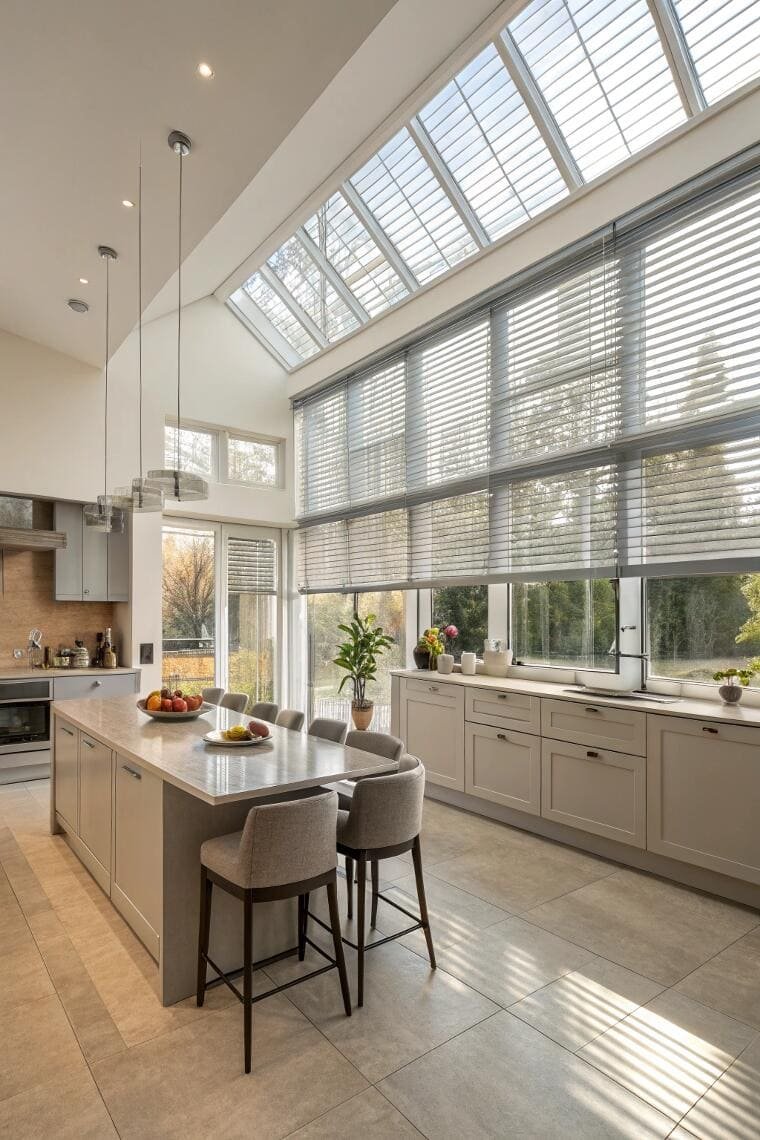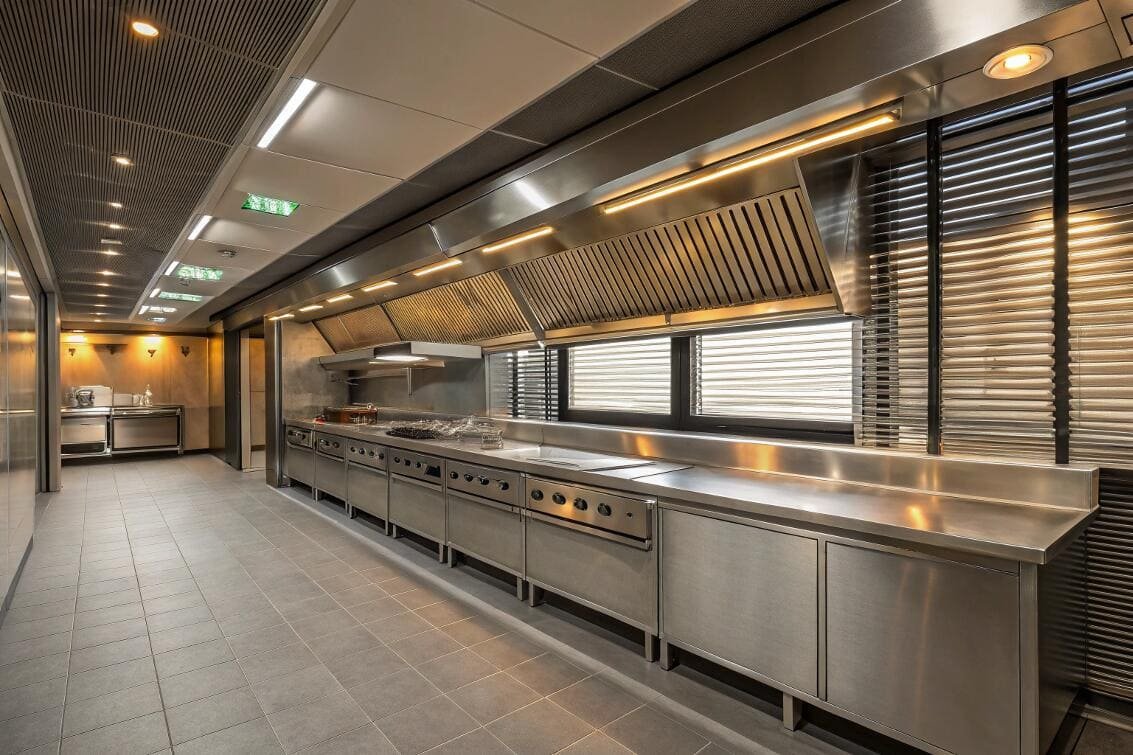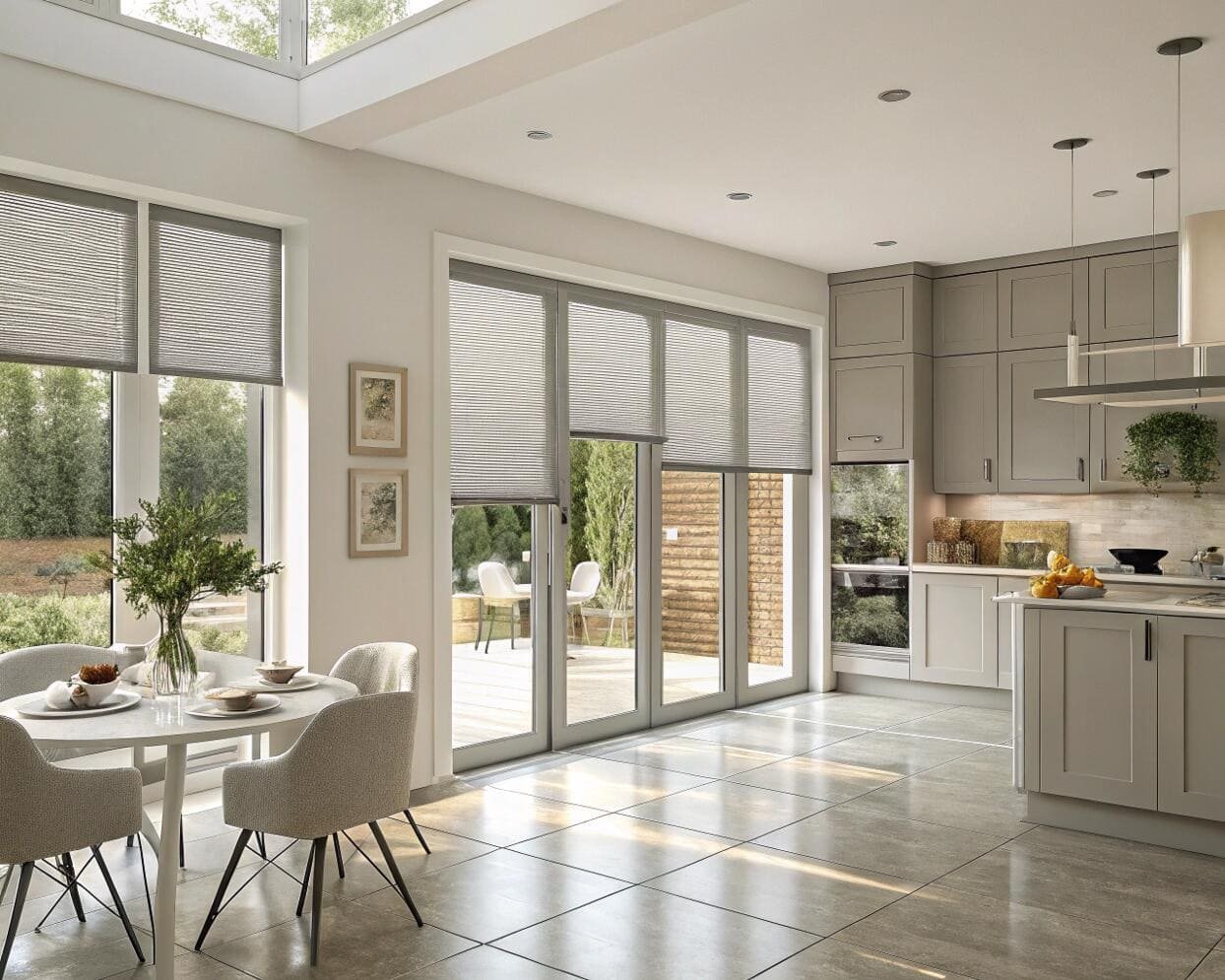Kitchen environments destroy standard blinds through heat exposure, grease accumulation, and moisture damage. Professional-grade blinds solve these challenges with specialized materials and construction.
Aluminum blinds with heat-resistant coatings[^1] and PVC blinds with non-porous surfaces provide optimal kitchen performance. These materials withstand cooking temperatures, resist grease buildup, and enable easy cleaning that maintains hygiene standards.

I've replaced countless kitchen blinds that failed within months due to heat damage and grease accumulation. The difference between standard and kitchen-grade blinds becomes obvious the first time you try to clean cooking residue from fabric slats.
What blinds are best for heat blocking?
Heat-blocking blinds require reflective materials and specialized coatings that deflect solar radiation while withstanding cooking temperatures. Aluminum blinds provide superior heat blocking performance[^2].
Aluminum blinds with reflective coatings offer the best heat blocking performance for kitchens. They deflect up to 80% of solar heat while maintaining structural integrity under cooking temperatures that damage fabric and wooden alternatives.

The heat blocking requirements for kitchen blinds exceed standard residential applications due to dual heat sources from cooking equipment and solar radiation. Effective heat blocking requires understanding thermal properties and material selection.
Reflective coating technology enables aluminum blinds to achieve superior heat blocking performance. These specialized coatings reflect infrared radiation before it penetrates interior spaces, reducing cooling costs and maintaining comfortable kitchen temperatures during peak cooking periods.
Thermal conductivity analysis reveals why aluminum blinds outperform alternatives for heat blocking. While aluminum conducts heat, the thin slat construction and reflective coatings[^3] prevent significant heat transfer. Fabric blinds absorb heat and transfer it to interior spaces, while wooden blinds can warp under thermal stress.
Solar heat gain coefficient measurements show aluminum blinds with reflective coatings achieve 0.15-0.25 values compared to 0.40-0.60 for fabric alternatives. This performance difference translates to measurable energy savings and improved kitchen comfort during hot weather periods.
Multi-layer coating systems provide enhanced heat blocking through selective reflection and absorption properties. These advanced coatings reflect visible and near-infrared radiation while allowing beneficial natural light penetration for kitchen visibility requirements.
Installation orientation affects heat blocking performance significantly. Proper slat angle adjustment maximizes reflection while maintaining privacy and light control. Professional installation ensures optimal positioning for maximum heat rejection throughout daily sun angle changes.
Durability considerations include coating adhesion[^4] and thermal cycling resistance. Quality heat-blocking coatings maintain performance despite temperature fluctuations from cooking equipment and seasonal weather changes. Inferior coatings may degrade under thermal stress, reducing effectiveness over time.
Heat Blocking Performance Analysis
Material Comparison:
- Aluminum with reflective coating: 80% heat reflection, excellent durability
- PVC with thermal barrier: 60% heat reflection, good chemical resistance
- Composite with insulation: 70% heat reflection, enhanced aesthetics
- Fabric treatments: 30% heat reflection, poor durability in kitchen environments
Performance Factors:
- Solar heat gain coefficient optimization for energy efficiency
- Thermal conductivity management through material selection
- Coating durability under temperature cycling and cooking exposure
- Professional installation for optimal heat rejection angles
Energy Efficiency Benefits:
- Reduced cooling costs during peak summer periods
- Improved kitchen comfort through heat load reduction
- Enhanced HVAC system efficiency through reduced solar gain
- Measurable energy savings with professional heat load calculations
Which window blinds are easiest to clean?
Easy-clean blinds feature non-porous surfaces, grease-resistant coatings[^5], and construction that prevents accumulation of cooking residue. Aluminum and PVC blinds provide superior cleaning convenience.
Aluminum blinds with smooth, non-porous surfaces are easiest to clean in kitchen environments. They resist grease adhesion, allow simple wipe-down cleaning, and maintain appearance despite exposure to cooking vapors and food preparation activities.

The cleaning requirements for kitchen blinds exceed other interior applications due to airborne grease, cooking vapors, and food preparation residue. Surfaces that seem easy to clean initially may become impossible to maintain without specialized materials.
Surface texture analysis reveals why smooth, non-porous materials clean more easily than textured alternatives. Grease and cooking residue adhere to textured surfaces and penetrate porous materials, making removal difficult. Smooth aluminum and PVC surfaces allow simple cleaning with standard household products.
Chemical resistance properties enable easy cleaning without surface damage. Quality kitchen blinds resist degradation from degreasers, disinfectants, and high-pH cleaning products required for kitchen hygiene. Standard blinds may discolor or deteriorate under aggressive cleaning protocols.
Cleaning protocol efficiency varies dramatically between blind materials. Aluminum blinds require simple wiping with degreasing solutions, while fabric blinds may need professional cleaning or replacement. Wooden blinds require specialized treatments that may not remove all cooking residue.
Maintenance frequency depends on material selection and surface properties. Non-porous blinds maintain appearance with weekly cleaning, while porous materials may require daily attention to prevent permanent staining. Professional-grade materials reduce maintenance burden significantly.
Grease resistance testing shows aluminum blinds with specialized coatings prevent grease penetration that causes permanent staining. Untreated surfaces may develop buildup that requires aggressive cleaning or professional restoration to remove effectively.
Construction details affect cleaning accessibility. Smooth slat edges, sealed end caps, and minimal crevices prevent accumulation of cooking residue in areas that are difficult to clean. Professional-grade construction eliminates cleaning problem areas.
Cleaning Performance Evaluation
Material Cleaning Requirements:
- Aluminum blinds: Weekly wipe-down with standard degreasers
- PVC blinds: Bi-weekly cleaning with household cleaning products
- Composite blinds: Monthly deep cleaning with specialized products
- Fabric blinds: Professional cleaning or frequent replacement required
Surface Properties:
- Non-porous surfaces prevent grease penetration and staining
- Smooth textures enable simple wipe-down cleaning procedures
- Chemical resistance maintains appearance despite aggressive cleaning
- Specialized coatings provide enhanced grease and stain resistance
Maintenance Efficiency:
- Reduced cleaning time through proper material selection
- Lower maintenance costs with durable, easy-clean surfaces
- Professional cleaning services available for complex installations
- Replacement scheduling optimization through durability analysis
What are the best blinds for kitchen windows?
Kitchen blinds must combine heat resistance, easy cleaning, moisture tolerance[^6], and grease resistance. Aluminum blinds consistently outperform alternatives in demanding kitchen environments.
Aluminum blinds with heat-resistant coatings and grease-resistant surfaces provide the best kitchen window performance. They withstand cooking temperatures, resist moisture damage, clean easily, and maintain appearance despite challenging kitchen conditions.

The performance requirements for kitchen blinds combine multiple challenging conditions that eliminate most standard blind options. Successful kitchen blinds must excel in heat resistance, moisture tolerance, grease resistance, and cleaning convenience simultaneously.
Temperature resistance analysis shows kitchen blinds face temperatures from cooking equipment that can reach 200-300°F near ranges and ovens. Aluminum blinds maintain structural integrity and operation at these temperatures, while fabric and wooden alternatives may warp, discolor, or fail mechanically.
Moisture tolerance becomes critical in kitchen environments where steam from cooking creates humidity levels that damage standard materials. Aluminum blinds with proper coatings resist corrosion and maintain smooth operation despite regular moisture exposure from cooking activities.
Grease resistance properties determine long-term appearance and hygiene maintenance. Aluminum surfaces with specialized coatings resist grease adhesion and allow effective cleaning. Fabric blinds absorb grease and may become permanently stained, while wooden blinds may develop buildup that requires professional restoration.
Light control requirements in kitchens include glare reduction for food preparation while maintaining adequate visibility for cooking tasks. Aluminum blinds provide precise light control through adjustable slats that optimize lighting conditions throughout daily cooking activities.
Durability expectations for kitchen blinds include resistance to temperature cycling, chemical cleaning products, and mechanical wear from frequent operation. Quality aluminum blinds provide 7-10 years of reliable service in kitchen environments compared to 12-18 months for standard alternatives.
Safety considerations include fire resistance and non-toxic materials that won't emit harmful vapors when exposed to cooking temperatures. Aluminum blinds meet fire safety standards and don't release toxic compounds under normal kitchen temperature exposure.
Kitchen Blind Performance Requirements
Essential Properties:
- Heat resistance to 300°F without degradation or warping
- Moisture tolerance preventing corrosion and operational failure
- Grease resistance enabling easy cleaning and stain prevention
- Chemical resistance maintaining appearance despite aggressive cleaning
Performance Standards:
- Temperature cycling resistance for long-term durability
- Mechanical reliability under frequent daily operation
- Fire safety compliance for kitchen installation requirements
- Non-toxic materials safe for food preparation environments
Installation Considerations:
- Professional mounting resistant to heat and moisture exposure
- Proper clearance from cooking equipment for safety
- Ventilation coordination for optimal moisture and heat management
- Integration with kitchen design and functionality requirements
What material is best for kitchen blinds?
Aluminum provides the best overall performance for kitchen blind applications. It combines heat resistance, moisture tolerance, easy cleaning, and durability that other materials cannot match.
Aluminum is the best material for kitchen blinds due to its heat resistance, non-porous surface, corrosion resistance, and easy maintenance. Aluminum blinds outperform fabric, wood, and plastic alternatives in demanding kitchen environments.

Material selection for kitchen blinds requires balancing multiple performance requirements that challenge standard blind materials. Aluminum consistently provides superior performance across all critical kitchen application factors.
Heat resistance comparison shows aluminum maintains structural integrity and appearance at cooking temperatures that damage alternatives. Aluminum's melting point of 1220°F provides substantial safety margin compared to plastic materials that may soften at 200°F and wooden materials that can warp or discolor under thermal stress.
Corrosion resistance properties enable aluminum blinds to withstand cooking moisture and cleaning chemicals without degradation. Proper aluminum alloys and coatings resist corrosion in kitchen environments that destroy steel components and cause wooden materials to deteriorate.
Chemical compatibility analysis reveals aluminum's resistance to kitchen cleaning products including degreasers, disinfectants, and high-pH solutions. Fabric materials may stain permanently, wooden materials may require specialized treatments, and plastic materials may discolor under chemical exposure.
Mechanical properties including strength-to-weight ratio favor aluminum for kitchen applications. Aluminum blinds maintain smooth operation despite temperature cycling and moisture exposure that may cause binding in other materials. The lightweight construction reduces hardware stress and extends operational life.
Manufacturing advantages of aluminum include precision forming, consistent quality control, and specialized coating application. These advantages result in blinds with superior fit, finish, and performance compared to alternatives that may have manufacturing limitations.
Cost analysis must consider both initial investment and long-term value. While aluminum blinds may cost more initially, their extended lifespan and reduced maintenance requirements provide superior value in demanding kitchen environments.
Material Performance Analysis
Aluminum Advantages:
- Heat resistance to 1220°F melting point with no degradation at cooking temperatures
- Corrosion resistance maintaining performance in humid, chemical-exposed environments
- Non-porous surface enabling easy cleaning and grease resistance
- Mechanical reliability under temperature cycling and frequent operation
Alternative Material Limitations:
- Fabric blinds: Absorb grease, moisture, and odors with difficult cleaning
- Wooden blinds: Warp under heat, require specialized maintenance, absorb moisture
- Plastic blinds: May soften at cooking temperatures, chemical sensitivity
- Composite blinds: Variable performance depending on construction quality
Selection Criteria:
- Temperature resistance requirements based on kitchen equipment proximity
- Cleaning convenience needs for maintaining hygiene standards
- Durability expectations for long-term reliable operation
- Cost analysis including initial investment and maintenance expenses
What are the commercial-grade kitchen blind requirements for restaurants?
Commercial kitchen blinds must meet health codes, fire safety standards, and durability requirements that exceed residential applications. Restaurant environments demand professional-grade materials and construction.
Commercial-grade kitchen blinds require non-porous materials, fire-resistant construction, easy sanitization capabilities, and health code compliance. Aluminum blinds with specialized coatings meet restaurant requirements for safety, hygiene, and durability.

Restaurant kitchen environments present the most demanding conditions for window treatments due to intense heat, grease exposure, rigorous cleaning requirements, and regulatory compliance needs. Commercial-grade blinds must exceed residential performance standards significantly.
Health code compliance requires materials and construction that can be cleaned and sanitized to eliminate foodborne illness risks. Non-porous surfaces that resist bacterial growth and can withstand sanitizing chemicals are essential for health inspector approval and food safety certification.
Fire safety standards for commercial kitchens exceed residential requirements due to increased fire risks from cooking equipment and grease exposure. Blinds must meet Class A fire rating requirements and resist ignition even under direct flame exposure that may occur during kitchen fires.
Cleaning protocol requirements include daily sanitization with commercial-grade chemicals that may damage residential blind materials. Commercial blinds must resist degradation from repeated exposure to strong degreasers, sanitizers, and high-temperature cleaning procedures.
Temperature exposure in commercial kitchens can exceed 400°F near commercial cooking equipment compared to residential cooking temperatures. Blinds must maintain structural integrity and operation under these extreme conditions without warping, discoloration, or mechanical failure.
Durability expectations include resistance to constant operation, chemical exposure, and temperature cycling that would destroy residential blinds within months. Commercial blinds must provide years of reliable service under conditions that challenge even professional-grade materials.
Regulatory compliance includes meeting local fire codes, health department requirements, and insurance standards for commercial food service operations. Professional installation and certification may be required for compliance verification and insurance coverage.
Commercial Kitchen Blind Standards
Health Code Compliance:
- Non-porous materials preventing bacterial growth and contamination
- Sanitization capability with commercial-grade cleaning chemicals
- Easy cleaning protocols for daily hygiene maintenance
- Health inspector approval for food service facility compliance
Fire Safety Requirements:
- Class A fire rating for commercial kitchen applications
- Flame resistance preventing ignition during kitchen fires
- Non-toxic material composition preventing harmful vapor emission
- Professional installation meeting fire code requirements
Durability Standards:
- Temperature resistance to 400°F+ commercial cooking conditions
- Chemical resistance to repeated sanitizer and degreaser exposure
- Mechanical reliability under constant daily operation
- Extended service life justifying commercial investment
Regulatory Compliance:
- Local fire code compliance for commercial food service
- Health department approval for restaurant operation
- Insurance requirement satisfaction for coverage eligibility
- Professional certification for installation and performance
How do aluminum blinds perform in high-temperature kitchen environments?
Aluminum blinds excel in high-temperature kitchen environments through superior heat resistance, thermal stability, and maintained operation despite temperature extremes that damage alternative materials.
Aluminum blinds perform excellently in high-temperature kitchens, maintaining structural integrity and smooth operation at temperatures up to 400°F. Their thermal properties and specialized coatings prevent warping, discoloration, and mechanical failure common in other materials.

High-temperature kitchen environments test blind materials beyond normal residential conditions, requiring specialized performance characteristics that aluminum provides consistently. Understanding thermal performance helps predict long-term reliability and maintenance requirements.
Thermal expansion properties of aluminum allow controlled dimensional changes without warping or binding. Aluminum's predictable expansion coefficient enables proper installation clearances that maintain smooth operation despite temperature fluctuations from cooking equipment and seasonal changes.
Heat dissipation characteristics enable aluminum blinds to transfer absorbed heat quickly, preventing accumulation that could cause warping or operational problems. This rapid heat dissipation maintains lower surface temperatures and prevents damage to mounting hardware and surrounding materials.
Coating stability under high temperatures determines long-term appearance and performance. Quality aluminum blinds feature powder coatings and anodized finishes that maintain color and surface properties at cooking temperatures. These specialized finishes resist fading, chalking, and degradation common in high-heat environments.
Mechanical performance analysis shows aluminum blinds maintain smooth operation despite thermal cycling between ambient and cooking temperatures. The material properties prevent binding, warping, and component failure that affect alternative materials under similar thermal stress.
Thermal shock resistance enables aluminum blinds to withstand rapid temperature changes from cooking equipment cycling without cracking or mechanical failure. This property is critical in commercial kitchens where temperature changes can be sudden and extreme.
Long-term durability testing demonstrates aluminum blinds maintain performance characteristics after years of high-temperature exposure. Accelerated aging tests show minimal degradation compared to significant deterioration observed in fabric, wooden, and plastic alternatives.
Installation considerations for high-temperature environments include proper clearance from heat sources, mounting hardware rated for thermal cycling, and ventilation coordination to manage heat buildup. Professional installation ensures optimal performance and safety in demanding thermal conditions.
High-Temperature Performance Analysis
Thermal Properties:
- Operating temperature range: -40°F to +400°F without degradation
- Thermal expansion coefficient: 13.1 x 10⁻⁶ per °F for predictable expansion
- Heat dissipation rate: Rapid transfer preventing accumulation and damage
- Thermal shock resistance: Withstands rapid temperature cycling
Performance Characteristics:
- Coating stability maintaining appearance and properties at cooking temperatures
- Mechanical reliability preventing binding and operational failure
- Dimensional stability preventing warping and distortion
- Hardware compatibility with thermal cycling requirements
Installation Requirements:
- Proper clearance from heat sources for safety and performance
- Thermal-rated mounting hardware for long-term reliability
- Ventilation coordination for heat management optimization
- Professional assessment for high-temperature application suitability
What are the fire safety standards for commercial kitchen window treatments?
Commercial kitchen window treatments must meet Class A fire ratings and resist flame spread to comply with fire safety codes. Aluminum blinds consistently exceed these requirements.
Commercial kitchen window treatments must achieve Class A fire ratings with flame spread ratings below 25 and smoke development ratings below 450. Aluminum blinds meet these standards while providing superior performance compared to fabric alternatives that may fail fire safety requirements.

Fire safety standards for commercial kitchens recognize the increased fire risk from cooking equipment, grease accumulation, and high-temperature operations. Window treatments must not contribute to fire spread or generate toxic smoke that could endanger occupants during evacuation.
Class A fire rating requirements include flame spread index below 25 and smoke developed index below 450 when tested according to ASTM E84 standards. These ratings ensure window treatments will not significantly contribute to fire growth or smoke generation during building fires.
Flame resistance testing evaluates material response to direct flame exposure typical in kitchen fires. Aluminum blinds resist ignition and do not support combustion, while fabric treatments may ignite quickly and contribute to fire spread throughout the space.
Smoke generation analysis measures toxic vapor production when materials are exposed to fire conditions. Aluminum blinds produce minimal smoke and no toxic gases, while synthetic materials may generate dangerous fumes that complicate evacuation and firefighting efforts.
Installation compliance includes proper mounting that maintains fire ratings and prevents window treatment failure during fire conditions. Professional installation ensures compliance with fire code requirements and maintains manufacturer warranties and certifications.
Code compliance verification requires documentation proving fire rating compliance for insurance coverage and regulatory approval. Professional suppliers provide certified test results and compliance documentation required for commercial kitchen installations.
Emergency response considerations include window treatment behavior during fire suppression activities. Aluminum blinds maintain structural integrity during sprinkler activation and firefighting operations, while alternative materials may collapse or interfere with emergency procedures.
Fire Safety Compliance Requirements
Testing Standards:
- ASTM E84 flame spread and smoke development testing
- UL 723 surface burning characteristics evaluation
- NFPA 701 flame resistance certification for commercial applications
- Local fire code compliance verification and documentation
Performance Requirements:
- Class A fire rating with flame spread index below 25
- Smoke development index below 450 for occupant safety
- Non-toxic smoke generation preventing evacuation hazards
- Structural integrity maintenance during fire suppression operations
Installation Standards:
- Professional mounting maintaining fire rating integrity
- Proper clearance from ignition sources for safety
- Documentation providing compliance verification for inspectors
- Warranty and certification maintenance through proper installation
Which kitchen blind materials meet health code requirements for food service?
Non-porous materials that resist bacterial growth and enable effective sanitization meet health code requirements for food service facilities. Aluminum blinds consistently satisfy these stringent standards.
Aluminum blinds with smooth, non-porous surfaces meet health code requirements for food service by preventing bacterial growth, enabling effective sanitization, and resisting contamination that could cause foodborne illness outbreaks.

Health code requirements for food service facilities focus on preventing contamination sources that could lead to foodborne illness. Window treatments must not harbor bacteria, be easily cleanable, and resist degradation from sanitizing chemicals used in commercial food preparation.
Non-porous surface requirements eliminate breeding grounds for bacteria, mold, and other pathogens that could contaminate food preparation areas. Aluminum blinds provide completely non-porous surfaces that meet the most stringent health code standards for food service facilities.
Sanitization capability must include resistance to commercial-grade sanitizers, degreasers, and disinfectants used in professional food service cleaning protocols. These chemicals are significantly stronger than residential cleaners and can damage materials not designed for commercial use.
Bacterial resistance properties prevent colonization of surfaces that could transfer pathogens to food or food preparation surfaces. Smooth aluminum surfaces resist bacterial adhesion and can be sanitized effectively with approved commercial cleaning procedures.
Chemical resistance ensures window treatments maintain integrity and cleanability despite repeated exposure to harsh cleaning chemicals. Degraded surfaces can develop microscopic cracks and crevices that harbor bacteria and resist cleaning efforts.
Cleaning protocol compatibility requires materials that can withstand daily sanitization schedules without degradation. Food service facilities typically require daily deep cleaning with chemicals that would destroy residential-grade window treatments within weeks.
Health inspector approval depends on demonstrating that window treatments meet or exceed health code requirements for non-porous surfaces, cleanability, and bacterial resistance. Professional documentation and certification may be required for approval.
Health Code Compliance Analysis
Material Requirements:
- Non-porous surfaces preventing bacterial colonization and growth
- Chemical resistance maintaining cleanability under sanitizer exposure
- Smooth finishes enabling effective cleaning and sanitization
- Professional-grade construction meeting commercial food service standards
Cleaning Compatibility:
- Daily sanitization protocols using commercial-grade chemicals
- Steam cleaning resistance for deep sanitization procedures
- Grease removal capability preventing contamination sources
- Professional cleaning service compatibility for maintenance outsourcing
Regulatory Compliance:
- Health department approval for food service facility installation
- Documentation providing compliance verification for inspectors
- Professional certification for installation and material specifications
- Ongoing maintenance protocols ensuring continued compliance
Conclusion
Kitchen blinds require specialized materials and construction to withstand heat, moisture, grease, and cleaning demands that destroy standard window treatments within months of installation.
Professional Kitchen Blind Solutions Built for Performance
Upgrade your kitchen with blinds engineered specifically for heat, grease, and moisture resistance. No more warped slats, permanent staining, or frequent replacements disrupting your culinary space.
Transform your kitchen environment with professional-grade blinds that withstand cooking temperatures, resist grease buildup, and clean effortlessly. Our aluminum blinds provide decades of reliable performance in demanding kitchen conditions.
Immediate performance advantages:
- Heat resistance to 400°F without warping or degradation
- Non-porous surfaces that prevent grease absorption and staining
- Easy daily cleaning with standard household degreasers
- Professional installation with heat and moisture barriers
Stop replacing failed kitchen blinds every year with systems designed for the unique challenges of cooking environments. Professional materials and installation eliminate the frustration of standard blind failures.
Complete kitchen blind solutions:
- Heat-resistant aluminum construction with specialized coatings
- Grease-resistant surfaces enabling effortless maintenance
- Professional installation optimized for kitchen environments
- Commercial-grade options meeting restaurant standards
Premium kitchen-grade features:
- Temperature cycling resistance maintaining smooth operation
- Chemical resistance preventing degradation from cleaning products
- Fire safety compliance for enhanced kitchen security
- Health code compliance for food service applications
Professional assessment includes:
- Kitchen heat zone analysis for optimal material selection
- Ventilation system evaluation for performance integration
- Custom specification for your specific cooking requirements
- Installation planning minimizing disruption to kitchen operations
Commercial kitchen capabilities:
- Health code compliant materials for restaurant applications
- Fire safety certified construction meeting commercial standards
- Daily sanitization protocols for food service facilities
- Professional maintenance programs ensuring regulatory compliance
Secure your kitchen blind upgrade:
Email: info@velablinds.com | WhatsApp: +86 13720128317
---
[^1]: Explore how these blinds can withstand high temperatures and enhance kitchen comfort.
[^2]: Discover the technology behind heat blocking blinds and their benefits for energy efficiency.
[^3]: Find out how reflective coatings enhance heat blocking and energy savings in kitchens.
[^4]: Learn how coating adhesion affects the longevity and performance of kitchen blinds.
[^5]: Learn how these coatings help maintain cleanliness in kitchen environments.
[^6]: Explore how moisture resistance prevents damage and maintains functionality.Partner with VelaBlinds for Your Next Project
Smart window treatments shouldn't be complicated. After working with 500+ distributors and contractors worldwide, I've streamlined the process to get you quality products, competitive pricing, and reliable support - every time.
Why project professionals choose VelaBlinds:
- ✅ Fast, Accurate Quotes - Detailed specs and pricing within 24 hours
- ✅ Transparent Pricing - No hidden fees, volume discounts clearly outlined
- ✅ Quality Assurance - Direct partnerships with certified OEM manufacturers
- ✅ Project Support - Dedicated account manager from quote to delivery
Start your next project:
📧 Quick Quote: Send your requirements to info@velablinds.com
📱 Direct Contact: WhatsApp +86 137 2012 8317
🌐 Browse Solutions: https://velablinds.com/
📁 Product Resources: Access spec sheets, catalogs & project files
Jimmy Chen, Founder
"I built VelaBlinds to solve the real challenges I faced as a project buyer - long lead times, unclear specs, and unreliable suppliers. Let's discuss how we can power your projects with smarter blinds."
Serving distributors and contractors across North America, Europe, and Australia since 2018.




